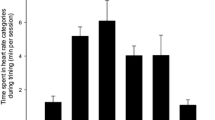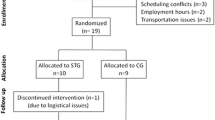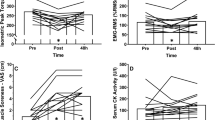Abstract
Purpose
The aim of the study was to investigate the effects of low-intensity running performed immediately after lower-body power-training sessions on power development.
Methods
Twenty young females participated in 6 weeks, 3/week, of either lower body power training (PT) or lower body power training followed by 30 min of low-intensity running (PET) eliciting 60–70 % of maximal heart rate. The following were measured before and after the training period: counter-movement jump, isometric leg press force and rate of force development (RFD), half squat 1-RM, vastus lateralis fiber type composition and cross sectional area, resting intramuscular fiber conduction velocity (MFCV), and heart rate during the modified Bruce treadmill test.
Results
Counter-movement jump height and peak power increased after PT (10.7 ± 6.2 and 12.9 ± 18.7 %, p < 0.05) but not after PET (3.4 ± 7.6 and 5.11 ± 10.94 %, p > 0.05). Maximum isometric force, RFD, and half squat 1-RM increased similarly in both groups. Muscle fiber type composition was not altered in either group. Muscle fiber cross sectional area increased only after PT (17.5 ± 17.4, 14.5 ± 10.4, 20.36 ± 11.3 %, in type I, IIA, and IIX fibers, respectively, p < 0.05). Likewise, mean MFCV increased with PT only (before: 4.53 ± 0.38 m s−1, after: 5.09 ± 0.39 m s−1, p = 0.027). Submaximal heart rate during the Bruce treadmill test remained unchanged after PT but decreased after PET.
Conclusion
These results suggest that low-intensity running performed after lower-body power training impairs the exercise-induced adaptation in stretch–shortening cycle jumping performance (vertical jump height, peak power), during the first 6 weeks of training, which may be partially linked to inhibited muscle fiber hypertrophy and muscle fiber conduction velocity.




Similar content being viewed by others
Abbreviations
- 1-RM:
-
One repetition maximum
- CI:
-
Confidence interval
- CMJ:
-
Counter-movement jump
- CSA:
-
Cross sectional area
- EMG:
-
Electromyography
- I:
-
Type I muscle fibers
- ICC:
-
Intraclass correlation coefficient
- IIA:
-
Type IIA muscle fibers
- IIX:
-
Type IIX muscle fibers
- Km h−1 :
-
Kilometres per hour
- MFCV:
-
Muscle fiber conduction velocity
- PT:
-
Power training
- PET:
-
Power endurance training
- RFD:
-
Rate of force development
- SSC:
-
Stretch-shortening cycle
- VO2max:
-
Maximal oxygen consumption
References
Aagaard P, Andersen JL (2010) Effects of strength training on endurance capacity in top-level endurance athletes. Scand J Med Sci Sports 20(Suppl 2):39–47
Aagaard P, Andersen JL, Dyhre-Poulsen P, Leffers A-M, Wagner A, Magnusson SP, Halkjaer J, Simonsen EB (2002) A mechanism for increased contractile strength of human pinnate muscle in response to strength training: changes in muscle architecture. J Physiol 534:613–623
Andersen JL, Aagaard P (2000) Myosin heavy chain IIX overshoot in human skeletal muscle. Muscle Nerve 23(7):1095–1104
Arendt-Nielsen L, Zwarts M (1989) Measurement of muscle fiber conduction velocity in humans: techniques and applications. J Clin Neurophysiol 6:173–190
Atherton PJ, Babraj J, Smith K, Singh J, Rennie MJ, Wackerhage H (2005) Selective activation of AMPK-PGC-1 alpha or PKB-TSC2-mTOR signaling can explain specific adaptive responses to endurance or resistance training-like electrical muscle stimulation. FASEB J 19:786–788
Baar K (2014) Using molecular biology to maximize concurrent training. Sports Med 44(Suppl 2):S117–S125
Beachle TR, Earle RW, Wathen D (2000) Resistance training. In: Beachle TR, Earle RW (eds) Essentials of strength training and conditioning. Human Kinetics, Champaign, pp 395–425
Blijham PJ, Ter Laak HJ, Schelhaas HJ, Van Engelen BG, Stegeman DF, Zwarts MJ (2006) Relation between muscle fiber conduction velocity and fiber size in neuromuscular disorders. J Appl Physiol 100:1837–1841
Blijham PJ, Schelhaas HJ, Ter Laak HJ, Van Engelen BG, Zwarts MJ (2007) Early diagnosis of ALS: the search for signs of denervation in clinically normal muscles. J Neurol Sci 263:154–157
Bogdanis G, Veligekas P, Selima E, Spengos K, Terzis G (2013) Changes in muscle fiber characteristics and leg power after short-term eccentric and ballistic resistance training. Med Sci Sports Exerc S 182:45(5)
Bogdanis GC, Tsoukos A, Veligekas P, Tsolakis C, Terzis G (2014) Effects of muscle action type with equal impulse of conditioning activity on postactivation potentiation. J Strength Cond Res 28(9):2521–2528
Bosco C, Luhtanen P, Komi PV (1983) A simple method for measurement of mechanical power in jumping. Eur J Appl Physiol Occup Physiol 50:273–282
Bottinelli R (2001) Functional heterogeneity of mammalian single muscle fibres: do myosin isoforms tell the whole story? Pflugers Arch 443(1):6–17
Bottinelli R, Canepari M, Pellegrino MA, Reggiani C (1996) Force-velocity properties of human skeletal muscle fibres: myosin heavy chain isoform and temperature dependence. J Physiol (Lond) 495:573–586
Brooke M, Kaiser K (1970a) Muscle fiber types. How many and what kind. Arch Neurol 23:369–379
Brooke M, Kaiser K (1970b) Three “myosin adenosine-triphosphatase” systems: the nature of their pH lability and sulfhydryl dependence. J Histochem Cytochem 18:670–672
Bruce RA, Kusumi F, Hosmer D (1973) Maximal oxygen intake and nomographic assessment of functional aerobic impairment in cardiovascular disease. Am Heart J 85(4):546–562
Cormie P, McGuigan MR, Newton RU (2011) Developing maximal neuromuscular power: part 2: training considerations for improving maximal power production. Sports Med 41(2):125–146
Hickson RC (1980) Interference of strength development by simultaneously training for strength and endurance. Eur J Appl Physiol Occup Physiol 45:255–263
Kereshi S, Manzano G, McComas AJ (1983) Impulse conduction velocities in human biceps brachii muscles. Exp Neurol 80:652–662
Kraemer WJ, Patton JF, Gordon SE, Harman EA, Deschenes MR, Reynolds K, Newton RU, Triplett NT, Dziados JE (1995) Compatibility of high-intensity strength and endurance training on hormonal and skeletal muscle adaptations. J Appl Physiol 78(3):976–989
Kyröläinen H, Avela J, McBride J, Koskinen S, Andersen J, Sipilä S, Takala T, Komi P (2005) Effects of power-training on muscle structure and neuromuscular performance. Scand J Med Sci Sports 15:58–64
Linthorne NP (2001) Analysis of standing vertical jumps using a force platform. Am J Phys 69:1198–1204
Marcora S, Miller KM (1999) The effect of knee angle on the external validity of isometric measures of lower body neuromuscular function. J Sports Sci 18:313–319
McBride A, Ghilagaber S, Nikolaev A, Hardie DG (2009) The glycogen-binding domain on the AMPK beta subunit allows the kinase to act as a glycogen sensor. Cell Metab 7(9):23–34
Mitrovic S, Lüder G, Hopf HC (1999) Muscle fiber conduction velocity at different states of isotonic contraction. Muscle Nerve 22:1126–1128
Pollock ML, Foster C, Schmidt D, Hellman C, Linnerud AC, Ward A (1982) Comparative analysis of physiologic responses to three different maximal graded exercise test protocols in healthy women. Am Heart J 103(3):363–373
Rønnestad BR, Mujika I (2014) Optimizing strength training for running and cycling endurance performance: a review. Scand J Med Sci Sports 24:603–612
Rose AJ, Brohol C, Kiillerich K, Finn SG, Proud CG, Rider MH, Richter EA, Kiens B (2005) Exercise rapidly increases eukaryotic elongation factor 2 phosphorylation in skeletal muscle of men. J Physiol 569:223–228
Sadoyama T, Masuda T, Miyata H, Katsuta S (1988) Fibre conduction velocity and fibre composition in human vastus lateralis. Eur J Appl Physiol Occup Physiol 57:767–771
Stålberg E (1966) Propagation velocity in human muscle fibers in situ. Acta Physiol Scand Suppl 287:1–112
Stålberg E (1979) Single fibre electromyography. Trends Neurosci 2:185–188
Stålberg E (1980) Some electrophysiological methods for the study of human muscle. J Biomed Engin 2:290–298
Staron RS, Karapondo DL, Kraemer WJ, Fry AC, Gordon SE, Falkel JE, Hagerman FC, Hikida RS (1994) Skeletal muscle adaptations during early phase of heavy resistance training in men and women. J Appl Physiol 76(3):1247–1255
Stasinaki AN, Gloumis G, Spengos K, Blazevich AJ, Zaras N, Georgiadis G, Karampatsos G, Terzis G (2015) Muscle strength, power and morphological adaptations after 6 weeks of compound vs complex training in healthy men. J Strength Cond Res 29(9):2559–2569
Stone J, Brannon T, Haddad F, Qin A, Baldwin KM (1996) Adaptive responses of hypertrophying skeletal muscle to endurance training. J Appl Physiol 81(2):665–672
Terzis G, Stratakos G, Manta P, Georgiadis G (2008) Throwing performance after resistance training and detraining. J Strength Cond Res 22:1198–1204
Terzis G, Spengos K, Kavouras S, Manta P, Georgiadis G (2010) Muscle fibre type composition and body composition in hammer throwers. J Sports Sci Med 9:104–109
Troni W, Cantello R, Rainero I (1983) Conduction velocity along human muscle fibers in situ. Neurology 33:1453
Vissing K, Brink M, Lønbro S, Sørensen H, Overgaard K, Danborg K, Mortensen J, Elstrøm O, Rosenhøj N, Ringgaard S (2008) Muscle adaptations to plyometric vs resistance training in untrained young men. J Strength Cond Res 22:1799–1810
Widrick JJ, Stelzer JE, Shoepe TC, Garner DP (2002) Functional properties of human muscle fibers after short-term resistance exercise training. Am J Physiol Regul Integr Comp Physiol 283:R408–R416
Wilson JM, Marin PJ, Rhea MR, Wilson SM, Loenneke JP, Anderson JC (2012) Concurrent training: a meta-analysis examining interference of aerobic and resistance exercises. J Strength Cond Res 26:2293–2307
Winchester JB, McBride JM, Maher MA, Mikat RP, Allen BK, Kline DE, McGuigan MR (2008) Eight weeks of ballistic exercise improves power independently of changes in strength and muscle fiber type expression. J Strength Cond Res 22:1728–1734
Zaras N, Spengos K, Methenitis S, Papadopoulos C, Karampatsos G, Georgiadis G, Stasinaki A, Manta P, Terzis G (2013) Effects of strength vs ballistic-power-training on throwing performance. J Sports Sci Med 12:130–137
Acknowledgments
We wish to thank Kavvoura A, Korfiatis P, Anousaki H, and Dr. Karampatsos G, for the co-supervision of a number of the training sessions. We also thank the participants for their efforts and consistency throughout the study.
Author information
Authors and Affiliations
Corresponding author
Ethics declarations
Conflict of interest
The authors declare no conflict of interest.
Ethical approval
All procedures performed in this study were in accordance with the ethical standards of the institutional research committee and with the 1964 Helsinki declaration and its later amendments or comparable ethical standards.
Additional information
Communicated by Peter Krustrup.
Rights and permissions
About this article
Cite this article
Terzis, G., Spengos, K., Methenitis, S. et al. Early phase interference between low-intensity running and power training in moderately trained females. Eur J Appl Physiol 116, 1063–1073 (2016). https://doi.org/10.1007/s00421-016-3369-z
Received:
Accepted:
Published:
Issue Date:
DOI: https://doi.org/10.1007/s00421-016-3369-z




